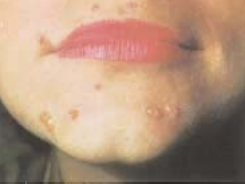The diseases discussed below are caused, at least in part, by autoimmune reactions. They are diagnosed by biopsy of lesions and by antibody studies.
Pemphigus is characterized by the formation of blisters (bullae) in the skin and mucous membranes caused by a separation of epidermal cells from underlying layers (Fig. 1). Rupture of these lesions leaves deeper areas of the skin unprotected from infection and fluid loss, much as in cases of burns. The cause is an auto-immune reaction to epithelial cells. Pemphigus is fatal unless treated by suppressing the immune system.
Lupus erythematosus (LE) is a chronic inflammatory autoimmune disease of connective tissue. The more widespread form of the disease, systemic lupus erythematosus (SLE), involves the skin and other organs. The discoid form (DLE) involves only the skin. It is seen as rough, raised, violet-tinted papules, usually limited to the face and scalp. There may also be a butterfly-shaped rash across the nose and cheeks that is typical of this disease.

FIGURE 21-4. Pemphigus, showing vesicles on the chin. (Reprinted with permission from Bickley LS. Bate's Guide to Physical Examination and History Taking. 8th Ed. Philadelphia: Lippincott Williams & Wilkins, 2003.)
The skin lesions of lupus are worsened by exposure to the ultraviolet radiation in sunlight. SLE is more prevalent in women than in men and has a higher incidence among Asians and blacks than in other populations.
Scleroderma is a disease of unknown cause that involves thickening and tightening of the skin. There is gradual fibrosis of the dermis because of overproduction of collagen. Sweat glands and hair follicles are also involved. A very early sign of scleroderma is Raynaud disease, in which blood vessels in the fingers and toes constrict in the cold, causing numbness, pain, coldness, and tingling. Skin symptoms first appear on the forearms and around the mouth. Internal organs become involved in a diffuse form of scleroderma called progressive systemic sclerosis (PSS).
责任编辑:admin
上一篇:医学文章阅读——Skin Cancer
下一篇:医学文章阅读——Dermatitis

微信公众号搜索“译员”关注我们,每天为您推送翻译理论和技巧,外语学习及翻译招聘信息。